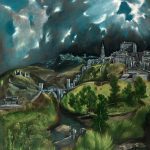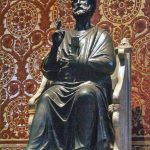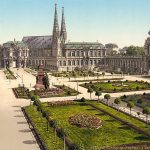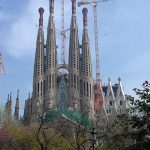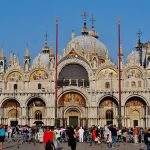
Nestled in the foothills of the Sierra de Guadarrama near Madrid, Spain, El Escorial stands as one of the country’s most significant historical landmarks. Officially known as the Royal Site of San Lorenzo de El Escorial, this grand complex combines a royal palace, basilica, monastery, library, and museum all within its expansive grounds. Built under the order of King Philip II, El Escorial was envisioned as a monumental tribute to Spanish power and faith during the 16th century, becoming a UNESCO World Heritage Site in 1984. Today, it serves as a symbol of Spain’s imperial past and a treasured site for visitors worldwide.
A Historical Overview of El Escorial
El Escorial was constructed between 1563 and 1584 as a grand architectural project under King Philip II. The Spanish king wanted a royal palace that would also serve as a monastery, mausoleum, and library, embodying both the power of the Spanish monarchy and the Catholic Church. Philip II selected Juan Bautista de Toledo, a Spanish architect who had previously worked on St. Peter’s Basilica in the Vatican, to bring his vision to life. After Toledo’s death, architect Juan de Herrera completed the project, leaving a lasting mark with his distinctive architectural style known as “Herrerian.”
The complex was dedicated to St. Lawrence, reflecting Philip II’s deep religious convictions. It was constructed in part to commemorate the Spanish victory over the French at the Battle of St. Quentin on St. Lawrence’s feast day. El Escorial became not only a royal residence but also the burial site for many Spanish monarchs, including Philip II himself, making it a cornerstone of Spanish royal history.
El Escorial’s Architectural Marvels
The architecture of El Escorial reflects a blend of Renaissance, Classical, and Herrerian styles, marked by simplicity, symmetry, and grandeur. The structure is built primarily from granite, with its facades adorned by simple yet majestic stone walls and a collection of statues and frescoes that depict important religious and historical figures. The basilica, with its grand dome and intricate frescoes, lies at the heart of the complex, embodying the spiritual center of El Escorial.
The intricate designs within the basilica highlight the artistry of prominent Renaissance artists, including frescoes by Pellegrino Tibaldi. The library, one of the most impressive parts of El Escorial, contains an invaluable collection of manuscripts, ancient books, and classical texts. Its ceiling frescoes, painted by Italian artist Luca Giordano, showcase allegorical representations of the seven liberal arts, enriching the visual and intellectual experience.
The Basilica: Spiritual Center of El Escorial
The basilica within El Escorial is a remarkable architectural feat, designed to be the spiritual heart of the complex. Its grand dome, reminiscent of St. Peter’s Basilica, and its vast interior space create an atmosphere of reverence. The basilica houses numerous chapels, intricate altars, and artworks that portray scenes from the life of Christ and various saints. The main altar, crafted in marble and gilded bronze, stands as a central piece, highlighting the church’s dedication to the Catholic faith.
The basilica also contains the Panteón de Reyes, or Pantheon of the Kings, where many Spanish royals are entombed. This circular burial chamber, lined with black and gold marble, holds the remains of monarchs such as Charles V and Philip II. This solemn space underscores the role of El Escorial as not just a palace but a mausoleum for Spain’s rulers.
The Royal Library: A Treasure of Knowledge
One of the most prized sections of El Escorial is its Royal Library, a sanctuary of knowledge with a collection spanning centuries. Philip II envisioned the library as a place for scholars and intellectuals, housing works on theology, philosophy, science, and history. With over 40,000 volumes, the library’s significance lies in its diverse collection, which includes ancient manuscripts and works of classical scholars.
The library’s architectural design is equally impressive, with vaulted ceilings adorned with frescoes depicting the seven liberal arts. These frescoes add an intellectual and artistic depth, celebrating the importance of knowledge and learning in Renaissance Spain. The library remains an essential destination for those interested in historical texts and the intellectual heritage of the Spanish Empire.
The Monastery: A Hub of Religious Life
The monastery at El Escorial was established for the Hieronymite monks and later passed to the Augustinians, embodying the religious vision of Philip II. It was a center for monastic life, with monks residing here to practice their religious devotion and scholarly pursuits. The monks were integral to the daily function of El Escorial, contributing to its spiritual and cultural life.
With its cloisters and cells, the monastery offered a serene environment for prayer and contemplation. The monastic quarters are designed in harmony with the rest of the complex, reflecting a balance between simplicity and elegance. The monks also played a role in maintaining the vast library and other intellectual aspects of El Escorial, contributing to the cultural richness of the site.
The Palace: Royal Residence and Legacy
El Escorial also served as a royal residence for the Spanish monarchy, designed to reflect the grandeur and authority of the Spanish crown. The rooms and halls of the palace are modestly adorned, in line with the austere tastes of Philip II, who preferred a simple, pious lifestyle. Despite its restrained decoration, the palace holds numerous portraits, tapestries, and furnishings that offer a glimpse into the life of the Spanish royals.
The palace includes the Hall of Battles, a gallery featuring murals depicting key military victories of the Spanish Empire. These murals celebrate Spain’s historic achievements, reflecting the power and influence of the monarchy during Philip II’s reign. This hall is an essential part of El Escorial, connecting the royal legacy to the broader narrative of Spain’s imperial history.
Gardens of El Escorial: A Natural Escape
Surrounding El Escorial are beautifully manicured gardens that offer a tranquil space for reflection and leisure. These gardens, often referred to as the “Gardens of the Friars,” are designed in a formal style with symmetrical paths, trimmed hedges, and fountains. The gardens were intended as a place for the monks to find solace and as a space for the royal family to enjoy nature.
The peaceful ambiance of the gardens provides a scenic contrast to the architectural grandeur of El Escorial. From here, visitors can take in views of the surrounding mountains and countryside, adding a natural beauty to the historic allure of the site.
El Escorial’s Cultural Significance Today
Today, El Escorial stands as a symbol of Spain’s cultural and historical heritage. It attracts visitors from around the world, eager to explore its architecture, art, and history. The complex plays a significant role in educating visitors about Spain’s imperial past and its relationship with the Catholic Church, providing insight into the country’s religious and political history.
As a UNESCO World Heritage Site, El Escorial receives preservation efforts to maintain its architectural and cultural legacy. Its combination of spiritual, royal, and intellectual elements makes it a unique destination that reflects the multifaceted history of Spain.
Visiting El Escorial: Practical Information
For those planning a visit to El Escorial, the site is located about 45 kilometers from Madrid and is easily accessible by train or car. The town of San Lorenzo de El Escorial, where the complex is located, offers additional attractions and accommodations for visitors.
The site generally opens year-round, with guided tours available that delve into the history and significance of each section. The ticketed entry includes access to the basilica, library, palace, and gardens, providing a comprehensive experience of this Spanish landmark. A visit to El Escorial offers an immersive journey into Spain’s rich past, allowing visitors to connect with history in a profound way.
Conclusion
El Escorial is more than just an architectural masterpiece; it is a living testament to the Spanish Renaissance and the profound legacy of King Philip II. The complex stands as a symbol of faith, power, and knowledge, encapsulating Spain’s imperial zenith. Today, it remains a cherished monument, offering a unique window into Spain’s religious and royal traditions. Visiting El Escorial is not only an exploration of history but also an experience of timeless beauty and grandeur.
Key Takeaways
- El Escorial is a historic complex near Madrid, built by King Philip II.
- The site includes a palace, basilica, library, and monastery.
- It combines Renaissance and Classical architecture, reflecting Spanish heritage.
- El Escorial’s Royal Library holds over 40,000 historical volumes.
- The Gardens of the Friars offer a serene escape in a natural setting.
FAQs
- What is the purpose of El Escorial?
- It served as a royal residence, monastery, library, and mausoleum for Spanish royalty.
- How do I get to El Escorial?
- El Escorial is accessible by train or car from Madrid, located 45 kilometers away.
- Is El Escorial a UNESCO site?
- Yes, El Escorial was designated a UNESCO World Heritage Site in 1984.
- What are the main attractions within El Escorial?
- Key areas include the basilica, library, palace, Hall of Battles, and the gardens.



